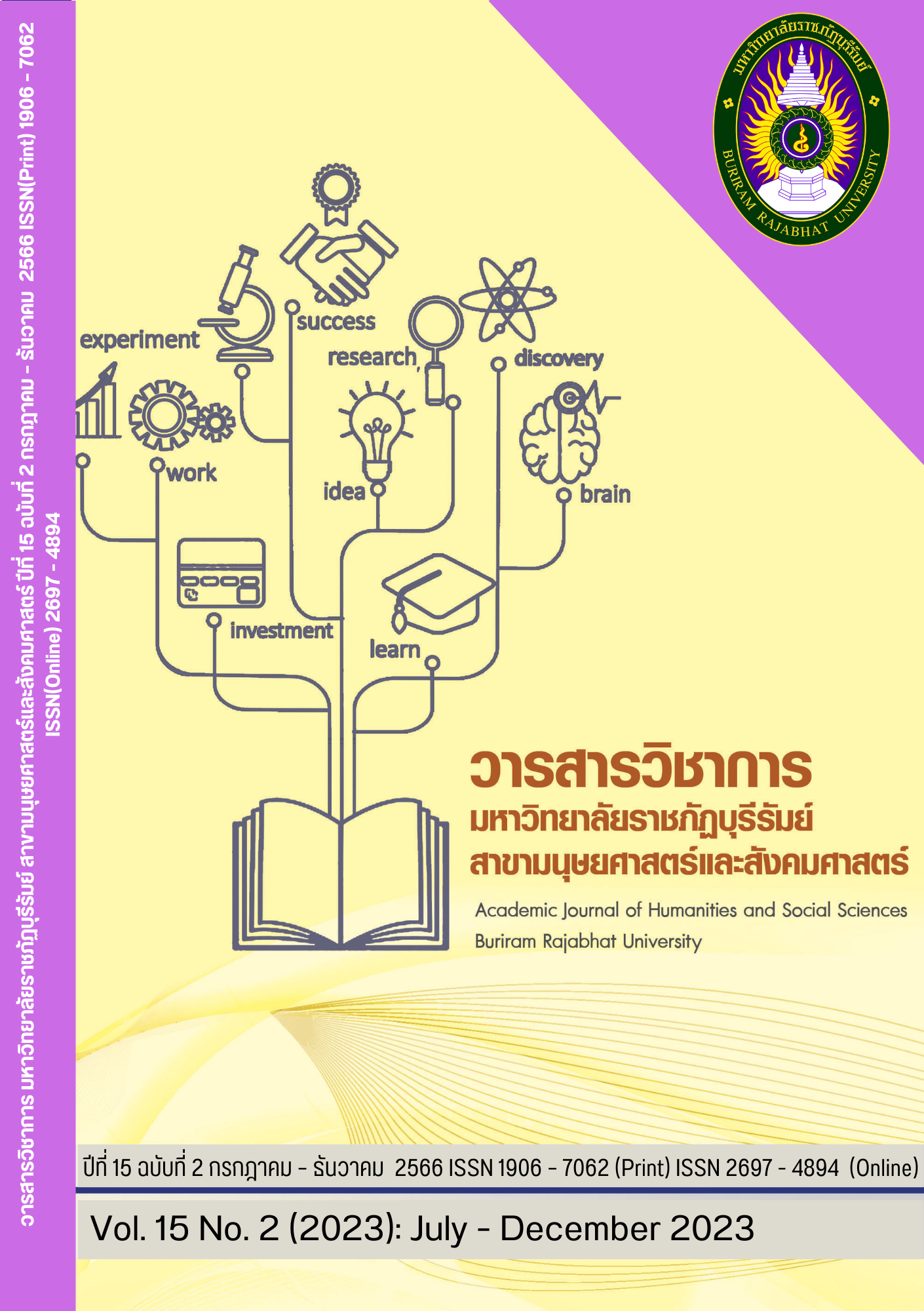Type, Kind, or Sort: Exploring Near Synonyms through Corpus Analysis
Main Article Content
บทคัดย่อ
One of key problems in learning vocabulary among second language learners is near synonyms. Previous studies explored different sets of near synonyms to contribute the evidence-based knowledge for L2 learners and classroom implantation. This study aims to investigate the differences among three synonyms e.g., type, kind and sort and study the noun and adjective collocations in relation to semantic preferences. Using the Corpus of Contemporary American English, it examines the frequency of these words across various genres and their noun and adjective collocations, selected based on the significant MI score level of ≥ 3 and categorized by theme. The findings found that these synonyms, despite some similarities, cannot be used interchangeably as their usage varies across genres. The word ‘type’ is predominantly linked with medical contexts while ‘kind’ and ‘sort’ often appear in discussions about groupings and classifications. The study emphasizes the importance of incorporating these insights into teaching materials and classroom strategies to enhance the vocabulary acquisition process for L2 learners, ensuring a more precise and comprehensive grasp of language usage.
Article Details

อนุญาตภายใต้เงื่อนไข Creative Commons Attribution-NonCommercial-NoDerivatives 4.0 International License.
- ต้นฉบับที่ได้รับการตีพิมพ์ในวารสารวิชาการ มหาวิทยาลัยราชภัฏบุรีรัมย์ สาขามนุษยศาสตร์และสังคมศาสตร์ ถือเป็นกรรมสิทธิ์ของมหาวิทยาลัยราชภัฏบุรีรัมย์ ห้ามนำข้อความทั้งหมดหรือบางส่วนไปพิมพ์ซ้ำเว้นเสียแต่ว่าจะได้รับอนุญาตจากมหาวิทยาลัยฯ เป็นลายลักษณ์อักษร
- เนื้อหาต้นฉบับที่ปรากฏในวารสารเป็นความรับผิดชอบของผู้เขียน ทั้งนี้ไม่รวมความผิดพลาด อันเกิดจากเทคนิคการพิมพ์
เอกสารอ้างอิง
Aimjirakul, P. (2015). Big and Large as Near Synonyms. Thammasat Review, 16(3), 1–15.
Ayhan Yavuz. (2014). Materials Development for Adult Learners in Teaching Vocabulary. Sino-US English Teaching, 11(4).
Biber, D. (2006). University language: a corpus-based study of spoken and written registers. In Studies in corpus linguistics.
Biber, D. (2009). A corpus-driven approach to formulaic language in English. International Journal of Corpus Linguistics, 14(3), 275–311.
Celen, K. M., & Yalçin, Ş. (2021). The Effects of Vocabulary Resources Use on Lexical Richness in L2 Writing. Milli Egitim, 50(230).
Chaokongjakra, W. (2023). Is it ‘important,’ ‘significant,’ or ‘crucial’? A Corpus Based Study of English Synonyms. LEARN Journal: Language Education and Acquisition Research Network, 16(2).
Chung, S.-F. (2011). A Corpus-based Analysis of “Create” and “Produce.” Chang Gung Journal of Humanities and Social Sciences, 4(2).
Fang, L., Ma, Q., & Yan, J. (2021). The effectiveness of corpus-based training on collocation use in L2 writing for Chinese senior secondary school students. Journal of China Computer-Assisted Language Learning, 1(1).
Gablasova, D., Brezina, V., & McEnery, T. (2017). Collocations in Corpus-Based Language Learning Research: Identifying, Comparing, and Interpreting the Evidence. In Language Learning (Vol. 67).
Jirananthiporn, S. (2018). Is this problem giving you trouble? A corpus-based examination of the differences between the nouns problem and trouble. Thoughts, 2, 1–25.
Kamali Khalavi, S., & Zeraatpishe, M. (2023). Relationship of Iranian EFL Learners’ Vocabulary Depth with Their Writing Vocabulary Use, Fluency, and Organization. Journal of Contemporary Language Research, 2(1).
KOÇAK, A. (2020). EFL Students’ Perceptions of Using COCA to Develop Their Vocabulary. Journal of Language Research, 4(1).
Kruawong, T., & Phoocharoensil, S. (2022). A Genre and Collocational Analysis of The Near-Synonyms Teach, Educate and Instruct: A Corpus-Based Approach. Teflin Journal, 33(1).
Laufer, B. (1990). Ease and Difficulty in Vocabulary Learning: Some Teaching Implications. Foreign Language Annals, 23(2).
Lei, L., & Liu, D. (2016). A new medical academic word list: A corpus-based study with enhanced methodology. Journal of English for Academic Purposes, 22.
Lertcharoenwanich, P. (2023). Analysis of Collocations and Semantic Preference of the Near-synonyms: Blank, Empty, and Vacant. LEARN Journal: Language Education and Acquisition Research Network, 16(1).
Lertcharoenwanich, P., & Phoocharoensil, S. (2022). A Corpus-based Study of the Near-synonyms: Purpose, Goal and Objective. REFLections, 29(1).
Petcharat, N., & Phoocharoensil, S. (2020). A Corpus-Based Study of English Synonyms: Chance and Opportunity. REFLections, 27(2), 218–245.
Phoocharoensil, S. (2013). Cross-linguistic influence: Its impact on L2 English collocation production. English Language Teaching, 6(1).
Phoocharoensil, S. (2020a). A Genre and Collocational Analysis of Consequence, Result, and Outcome. 3L: Language, Linguistics, Literature, 26(3).
Phoocharoensil, S. (2020b). Collocational patterns of the near-synonyms error, fault, and mistake. International Journal of Communication and Linguistic Studies, 19(1).
Phoocharoensil, S. (2021a). Multiword units and synonymy: Interface between collocations, colligations, and semantic prosody. GEMA Online Journal of Language Studies, 21(2).
Phoocharoensil, S. (2021b). Semantic prosody and collocation: A corpus study of the near-synonyms persist and persevere. Eurasian Journal of Applied Linguistics, 7(1), 240–258.
Phoocharoensil, S., & Kanokpermpoon, M. (2021). Distinguishing the near-synonyms ‘increase’ and ‘rise’: Genre and collocation investigation. Kasetsart Journal of Social Sciences, 42(4).
Sridhanyarat, K., & Phoocharoensil, S. (2023). A CORPUS-BASED INVESTIGATION OF ENGLISH NEAR-SYNONYMS: ASSESS, EVALUATE, AND MEASURE. Humanities, Arts and Social Sciences Studies, 23(1).
Taylor, J. R. (2003). Near synonyms as co-extensive categories: “High” and “tall” revisited. Language Sciences, 25(3).
Wilkins, David. (1972). Linguistics in language teaching. Edward Arnold.
Yaacob, A., Shapii, A., Saad Alobaisy, A., Al-Rahmi, W. M., Al-Dheleai, Y. M., Yahaya, N., & Alamri, M. M. (2019). Vocabulary Learning
Strategies Through Secondary Students at Saudi School in Malaysia. SAGE Open, 9(1)


